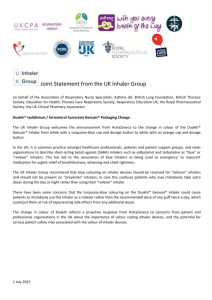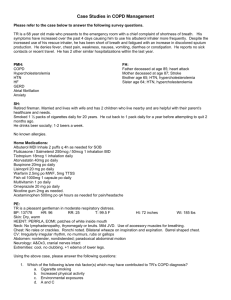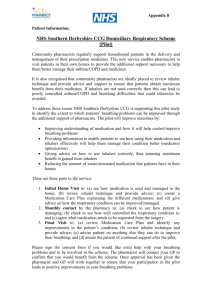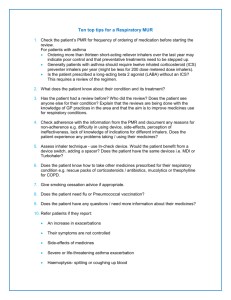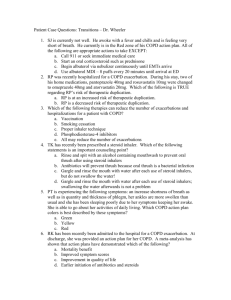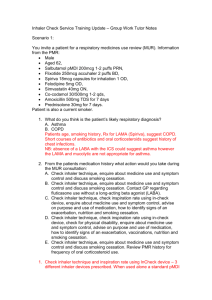File
advertisement
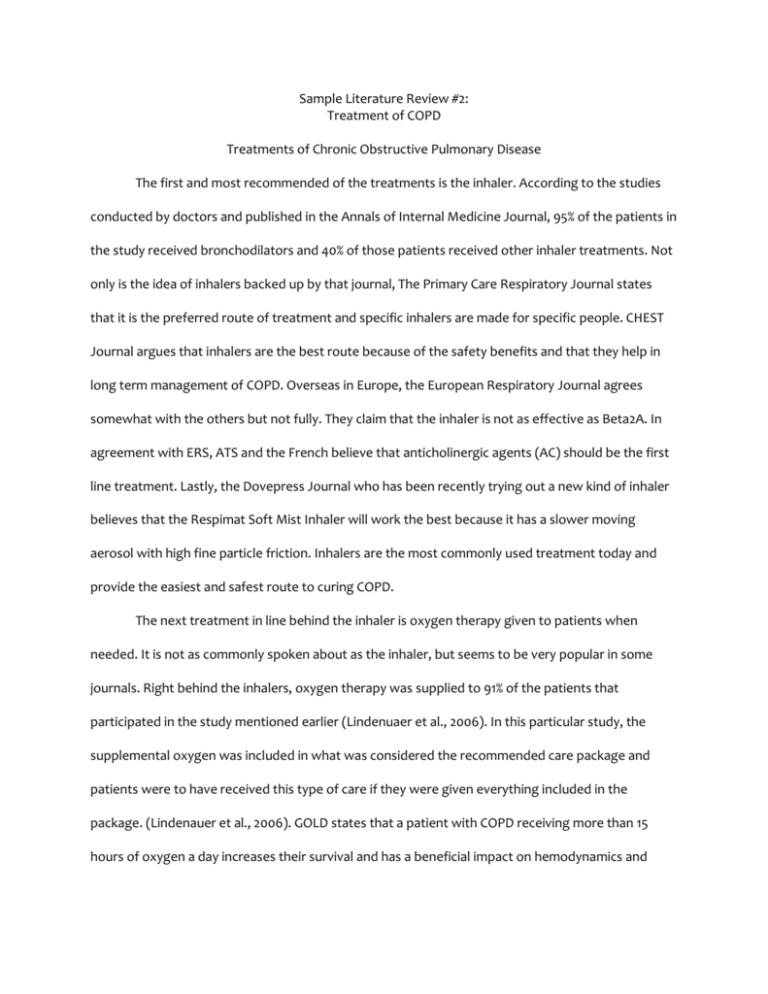
Sample Literature Review #2: Treatment of COPD Treatments of Chronic Obstructive Pulmonary Disease The first and most recommended of the treatments is the inhaler. According to the studies conducted by doctors and published in the Annals of Internal Medicine Journal, 95% of the patients in the study received bronchodilators and 40% of those patients received other inhaler treatments. Not only is the idea of inhalers backed up by that journal, The Primary Care Respiratory Journal states that it is the preferred route of treatment and specific inhalers are made for specific people. CHEST Journal argues that inhalers are the best route because of the safety benefits and that they help in long term management of COPD. Overseas in Europe, the European Respiratory Journal agrees somewhat with the others but not fully. They claim that the inhaler is not as effective as Beta2A. In agreement with ERS, ATS and the French believe that anticholinergic agents (AC) should be the first line treatment. Lastly, the Dovepress Journal who has been recently trying out a new kind of inhaler believes that the Respimat Soft Mist Inhaler will work the best because it has a slower moving aerosol with high fine particle friction. Inhalers are the most commonly used treatment today and provide the easiest and safest route to curing COPD. The next treatment in line behind the inhaler is oxygen therapy given to patients when needed. It is not as commonly spoken about as the inhaler, but seems to be very popular in some journals. Right behind the inhalers, oxygen therapy was supplied to 91% of the patients that participated in the study mentioned earlier (Lindenuaer et al., 2006). In this particular study, the supplemental oxygen was included in what was considered the recommended care package and patients were to have received this type of care if they were given everything included in the package. (Lindenauer et al., 2006). GOLD states that a patient with COPD receiving more than 15 hours of oxygen a day increases their survival and has a beneficial impact on hemodynamics and many other states of the body. Over a long period of time, the goal of supplemental oxygen is to increase the base line PaO2. Before patients receive one of the many treatments many are given a chest radiography to see the potential threat of their Chronic Obstructive Pulmonary Disease. This x-ray shows whether or not a probable cardiac failure is in the patients failure. (GOLD, 2009). This x-ray is most of the time very unlikely but is still performed for safety. GOLD argues that the radiography is rarely used while in the earlier study, chest radiography’s were performed on 95% of the patients. As with most diseases and conflicts with the body, antibiotics are always included in the treatment. According to the Pocket Guide to COPD published by GOLD and the CHEST journal, antibiotics should only be used in the case of infectious exacerbations and not for routine management. The exacerbations are symptoms of COPD that many experience before being diagnosed with the disease. On the contrary, studies published in the American Journal of Respiratory and Critical Care Medicine believe that COPD patients should be given antiobiotics at some point in their treatment care. Antibiotics include medicines such as Doxycycline. This is what doctors in the American Journal used and proved that it showed superiority over placebo treatments. One treatment that has been tested are inhaled and oral corticosteroids. These seem to be beneficial in the short term treating of acute exacerbations but not statements can be made about long term at this time (Pauwels, 2000). Inhaled corticosteroids are considered as of right now to be a second-line therapy but not long term on the lung function (Pawels, 2000). The oral corticosteroids are the ones that the treatment for the symptoms and onset of the disease. (Pauwels, 2000). Doctors with the American Journal of Respiratory Medicine claim that the corticosteroids mixed with antibiotics seem to be a successful treatment for patients. Corticosteroids are hormones that affect the blood electrolyte levels and inflammation. The last common treatment seen throughout research is the bronchodilator. This is a type of inhaler that can be used with other treatments. Increasing the number of them appears to be more effective than just increasing the dose of one. (GOLD 2009). This treatment is given only on an as needed basis and on a regular basis for symptoms. If the symptoms worsen, then the bronchodilator should be used more than it is regularly. (GOLD, 2009). The bronchodilators include B2 agonist or anticholinergic and sometimes a combination of both depending on the severity. (GOLD, 2009). Current Guidelines of COPD GOLD outlines the basics of the guidelines currently in use but a lot of other sources refer to their guidelines as the ideal care package. The development of guidelines is a well-documented process, and the development is based on evidence from well-controlled clinical studies (Pauwels, 2000). Inhalers are looked to as the first resort for treating COPD. Five out of seven sources agree that the inhaler is the most effective treatment. It is said that they help the most in long term management of COPD and offer the best safety benefits. (Pauwels, 2000). The only source that did not mention the use of inhalers at all was the American Journal of Respiratory and Critical Care Medicine. The mentioned more antibiotic use with corticosteroids than inhalers (Daniels et al., 2009). The next big concern in the development of guidelines is the overuse or misuse of certain medications. Age was a determination in the decision of who received the recommended package versus the non recommended package. (Lindenauer et at., 2006). The recommended package included all of the treatments available at the time of the study and the non recommended package included only receiving one or maybe more of the treatments (Lindenauer et at., 2006). Younger men were there to serve as guinea pigs for certain meds and were most likely the ones to receive the full package (Lindenauer et at., 2006). By using inhalers, The Primary Care Respiratory Journal doctors believe that you cannot overdose. They say that the medicine within the inhalers is not of enough strength to kill you (Vincken et al., 2009). In one study, the results show that inhalers should be given as needed on a regular basis and therefore the inhaler is neither misused nor overused. Overseas, the doctors and clinical specialists tested afterwards to see how much ICS prescriptions there were and how much AC and Beta2A showed up in the treatments (Roche et al., 2001). According to Dovepress Journal, the Respimat Soft Mist Inhaler which is a dry powder inhaler is breath actuated so the coordination and inhalation are unnecessary. The treatments done to test nebulizers prove that they are too bulky and are not a good choice for treating COPD (Hodder & Price, 2009). The ideal care package according to the Annals of Internal Medicine includes a chest radiography, supplemental oxygen, bronchodilatory therapy, systemic corticosteroid therapy, and an antibiotic treatment. These different types of treatments are considered the collection of processes needed to effectively care for patients with a particular condition (Lindenauer et al., 2006). The current guidelines explained in the Pocket Guide starts with patient education so that the patient knows what disease they have and how to cope with it. The list goes on to include: Bronchodilators, Vaccines, Antibiotics, Antitussives, and Oxygen Therapy (GOLD, 2009). Throughout many sources there are all kinds of inhalers, Theophylline, Supplemental Oxygen, and Rehab. The current treatment guidelines vary from source to source but all in all there is a basic outline of what works best when conquering Chronic Obstructive Pulmonary Disease.
